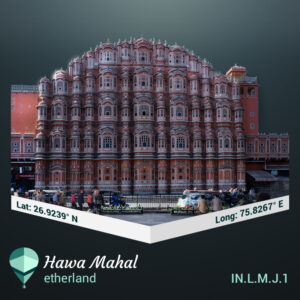 The Hawa Mahal is a stunning monument palace located in Jaipur, India. Maharaja Sawai Pratap Singh, Jai Singh’s grandson (founder of Jaipur), ordered the Hawa Mahal to be built in 1799. The architect in charge of the construction, Lal Chand Ustad, followed the Mughals and Islamic architectural styles, making this palace such a stunning piece to look at.
The Hawa Mahal is a stunning monument palace located in Jaipur, India. Maharaja Sawai Pratap Singh, Jai Singh’s grandson (founder of Jaipur), ordered the Hawa Mahal to be built in 1799. The architect in charge of the construction, Lal Chand Ustad, followed the Mughals and Islamic architectural styles, making this palace such a stunning piece to look at.
India is a land with many historical and cultural gems. The Hawa Mahal -translating as The or The Palace of Breeze- happens to be one of them. Standing high at the intersection of the main road in Jaipur, it is famous for its red and pink sandstone look, pyramidal five-story structure rising 15 meters high, and its 953 tiny windows locally known as jharokhas.
Hawa Mahal was constructed by the grandson of Jaipur’s founder, Maharaja Pratap Singh, in 1799. Different cultures of India inspired the structure, and it reflects in its style, being a fusion of Islamic Mughal and Hindu Rajput architectures. The small windows design was made intentionally, so royal females could observe daily life and festivals celebrated in front of the Palace without breaking the “purdah” rule. In fact, in Medieval India, it was prohibited for the women of the Palace to be seen publicly without face coverings.
On top of that, its peculiar window design was carefully thought out to allow the air to pass through and maintain a chill, ventilated atmosphere inside the Palace during the summer season, hence the naming Palace of Winds. The multitude of windows arranged in beautiful hanging cornices give the Palace a honeycomb look that adds to its architectural appeal from the exterior. The interior courtyard of the Palace welcomes visitors with beautiful fountains and a historically rich museum. Opened to the public in 1983, the museum displays a collection of antiques, relics, paintings, and various weapons once belonging to Jaipur’s Maharajas.
If the museum comes to feel dull or the narrow pathways sound too dizzying for some visitors, everyone will surely enjoy the beautiful view of the city, especially at dawn and dusk, from the Palace’s rooftop. A shopping area outside the Palace known as Bari Chaupal has several shops selling souvenirs, traditional clothing, jewelry, footwear, beautiful lamps, and vases. Some shops sell special sarees and handicrafts with unique Jaipuri style. Besides the shopping area, street vendors are also lined outside, on the main street, where tourists can enjoy traditional Indian street food like bhelpuri, samosas, kachori, and many more.
Situated at a prime location in Jaipur, Hawa Mahal is impossible to miss and a place where visitors can have a premium taste of Indian history, culture, and tradition. If you come to visit the Hawa Mahal, do not resist the temptation to take stylish pictures with your family and the pink-colored Palace in the background.